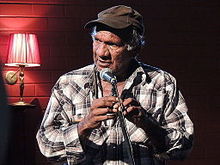Kevin Buzzacott

Kevin Buzzacott (born 1947), often referred to as Uncle Kev as an Aboriginal elder, is an Indigenous Australian from the Arabunna nation in northern South Australia. He has campaigned widely for cultural recognition, justice and land rights for Aboriginal people, and has initiated and led numerous campaigns including against uranium mining at Olympic Dam, South Australia on Kokatha land, and the exploitation of the water from the Great Artesian Basin.
He is affectionately known as "Uncle Kev", and is respected by both Indigenous and non-indigenous Australians for his ongoing efforts for protection of country, culture and spirit.
Awards[]
In 2001 Buzzacott was awarded the prestigious Nuclear-Free Future Award, in Ireland, which provided him with an opportunity to travel to Europe and speak to supporters of Indigenous land rights.[1]
The Australian Conservation Foundation awarded Buzzacott the 2007 Peter Rawlinson Award for two decades of work highlighting the impacts of uranium mining and promoting a nuclear free Australia.[2][3] ACF executive director Don Henry describing him in the award citation as
- A passionate and effective advocate for sustainable water management and for responsibility, respect and recognition of the rights, aspirations and traditional knowledge of Australia’s Indigenous peoples. Kevin is a cultural practitioner, an activist, an advocate and an educator. He has travelled tirelessly, talking to groups large and small about the impacts of uranium mining and the threats posed by the nuclear industry. Kevin has had a profound impact on the lives of many people – especially young people – with his many tours and "on-country" events. For many young activists "Uncle Kev" is truly an unsung hero and, against the current pro-nuclear tide, his is a very important struggle and story.[4]
Campaigns[]
In April 1999, the Minister for Foreign Affairs, Alexander Downer, and the Minister for the Environment, Robert Hill, formally refused to pursue the World Heritage listing of Lake Eyre, instead allowing a mining company, BHP Billiton to commence mining operations. The appellant, Buzzacott, claimed that Downer's failure to pursue World Heritage listing amounted to genocide against his people. Nulyarimma v Thompson was heard in the Federal Court of Australia and was decided in favour of the Government.[5]
Buzzacott initiated a peace walk from Lake Eyre to the 2000 Olympic Games in Sydney,[6][7] and another from the Olympic Dam uranium mine to Hiroshima, Japan.
In 2002 Buzzacott reclaimed his tribe's emu and kangaroo totems used in the Australian coat of arms from outside Parliament House, Canberra. He was arrested three years later at the Aboriginal Tent Embassy for theft of the coat of arms.[8] This resulted in a lengthy court battle where he served the government with a counter writ on charges of genocide.
In 2003 the Special Broadcasting Service and the Australian Film Commission Indigenous Unit produced a documentary called We of Little Voice in the "Australia By Numbers" series, which featured Buzzacott on a journey through northern South Australia to hear the stories of Aboriginal elders who have experienced the effects of the nuclear industry, from uranium mining to nuclear testing.[9]
He has given support to the Aboriginal Tent Embassy in Canberra, where he lit the Fire for Justice in 1998. He was also involved in Camp Sovereignty at the 2006 Commonwealth Games in Melbourne, referred to by many indigenous people as the Stolen-wealth Games.
In Melbourne on 21 April 2007 a group of non-indigenous and indigenous supporters raised money in support of his efforts to raise awareness about uranium mining issues.
In February 2012, Buzzacott legally challenged the Commonwealth Environment Minister Tony Burke's environmental approval of the Olympic Dam mine expansion. Environmental approval had been granted by state and federal governments in October 2011. Buzzacott was represented by the Environmental Defenders' Office and appeared in the Federal Court in Adelaide on 3 and 4 April 2012.[10] His challenge was unsuccessful and was dismissed on 20 April. An appeal of the judge's decision in 2013 was also unsuccessful.[11][12]
Documentary films[]
Buzzacott has featured in several documentary films, including First Fleet Back (2005),[13] Near and Far (in production[when?]) and shorts by filmmakers including Jessi Boylan[14] and Pip Starr.[15]
References[]
- ^ Kevin Buzzacott, 2001 Nuclear-Free Future Resistance Award Recipient Archived 6 July 2007 at the Wayback Machine Nuclear Free News. Accessed 8 June 2007
- ^ Aboriginal awarded environmental gong 5 June 2007. Accessed 8 May 2007
- ^ "Pip Starr Pictures". 10 April 2009. Archived from the original on 10 April 2009. Retrieved 1 April 2016.
- ^ Indigenous nuclear campaigner wins national environment award Australian Conservation Foundation, 5 June 2007. Accessed 8 June 2007
- ^ Nulyarimma v Thompson [1999] FCA 1192 Federal Court of Australia judgment, Austlii, Accessed 8 June 2007
- ^ Walking the Land for our Ancient Rights: Interview with Kevin Buzzacott Archived 12 September 2006 at the Wayback Machine Indigenous Law Bulletin [2000] ILB 6, Austlii. Accessed 8 June 2007
- ^ Unofficial flame to highlight Aboriginal issues ABC Online 2 September 2000. Accessed 8 May 2007
- ^ Police remove man from Aboriginal tent embassy Sydney Morning Herald, 6 April 2005. Accessed 8 June 2007
- ^ Australia By NUmbers Series 3 SBS. Accessed 8 June 2007
- ^ The Advertiser "Elder Kevin Buzzacott challenges decision to expand Olympic Dam" (2012-04-03)
- ^ ABC "Elder takes mine expansion plan to appeal court" (2012-06-22)
- ^ ABC "Elder loses legal fight against Olympic Dam" (9 October 2013) Retrieved 2013-11-30.
- ^ "First Fleet Back (2005) - Find a Film - Screen Australia". www.screenaustralia.gov.au. Retrieved 1 April 2016.
- ^ "Kevin Buzzacott, Lake Eyre, 2011". Retrieved 1 April 2016 – via Vimeo.
- ^ "pip starr: tributes". 2 April 2012. Archived from the original on 2 April 2012. Retrieved 1 April 2016.
External links[]
- Keepers of Lake Eyre website
- Short video of Uncle Kev in action by Pip Starr
- Tall Storeez
- Cuttlefish Country, a documentary film by Danimations
- 1947 births
- Living people
- Australian indigenous rights activists
- Australian anti-uranium activists
- Australian environmentalists
